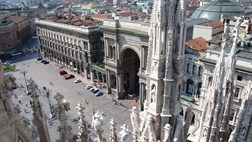Milan
 Baroque Milan was part of Habsburg rule in Spain (in 1535 Charles V, 1500-1558, finally absorbed the Duchy of Milan into the imperial possessions). The Spaniards fortified the city, giving it huge walls of over eleven kilometers (one of the largest in Europe), and entrusted the administration to a Governor. At the turn of the sixteenth and seventeenth centuries, two successive waves of the plague (1576 and 1630-1631) caused the halving of the population by more than 130,000 inhabitants in the first half of the sixteenth century which fell to about 60,000. During Spanish domination, the city lost the political centrality which it had acquired in the ducal era with the Visconti and Sforza families, but saw the leadership of the archbishop, often in conflict with the interests of the Spanish Crown and, in some cases, with the directives of Rome. At first, Charles (1560-1584) and then Federico (1595-1631) Borromeo were prestigious interpreters of patronage and ecclesiastical Counter-Reformation policies, with a massive reorganization of the diocesan structure. In 1647 there was an anti-Spanish conspiracy, which did not, however, enjoy the same following as in Naples and Palermo. During the Thirty Years’ War (1618-1648), the state of Milan was a political nerve center of the Spanish military. In 1655 the city was besieged by the French. In 1714, Milan officially passed under the dominion of the imperial dynasty of the Habsburgs of Austria and began its Enlightenment period.
Baroque Milan was part of Habsburg rule in Spain (in 1535 Charles V, 1500-1558, finally absorbed the Duchy of Milan into the imperial possessions). The Spaniards fortified the city, giving it huge walls of over eleven kilometers (one of the largest in Europe), and entrusted the administration to a Governor. At the turn of the sixteenth and seventeenth centuries, two successive waves of the plague (1576 and 1630-1631) caused the halving of the population by more than 130,000 inhabitants in the first half of the sixteenth century which fell to about 60,000. During Spanish domination, the city lost the political centrality which it had acquired in the ducal era with the Visconti and Sforza families, but saw the leadership of the archbishop, often in conflict with the interests of the Spanish Crown and, in some cases, with the directives of Rome. At first, Charles (1560-1584) and then Federico (1595-1631) Borromeo were prestigious interpreters of patronage and ecclesiastical Counter-Reformation policies, with a massive reorganization of the diocesan structure. In 1647 there was an anti-Spanish conspiracy, which did not, however, enjoy the same following as in Naples and Palermo. During the Thirty Years’ War (1618-1648), the state of Milan was a political nerve center of the Spanish military. In 1655 the city was besieged by the French. In 1714, Milan officially passed under the dominion of the imperial dynasty of the Habsburgs of Austria and began its Enlightenment period.
